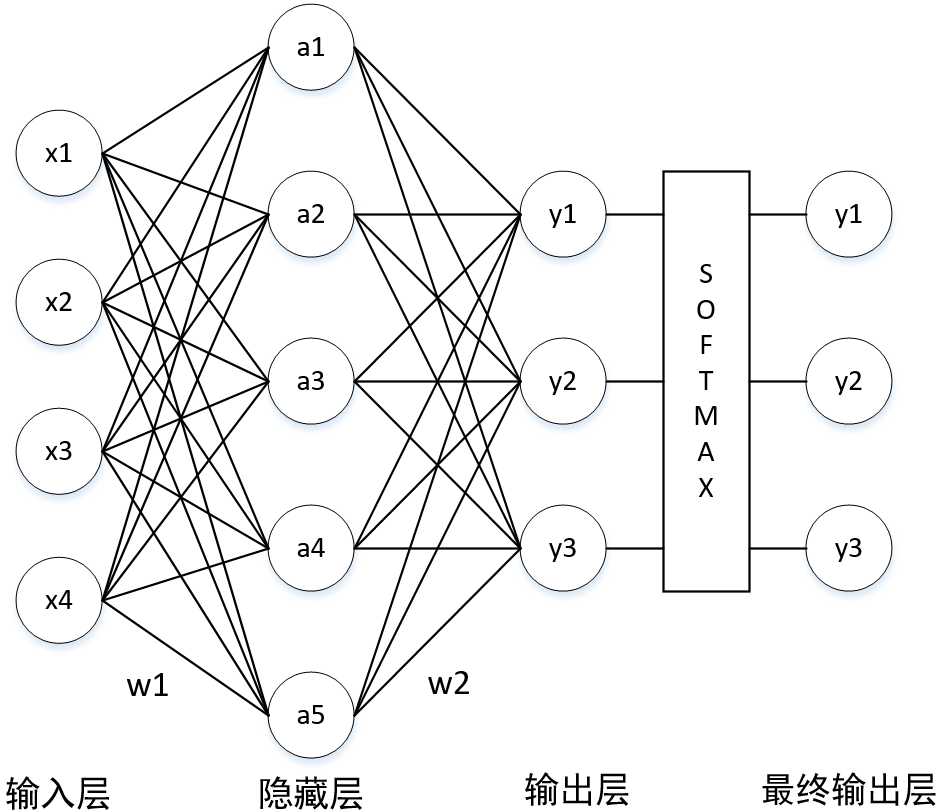标签:提高 算法 ase print feed and ica ret 表示

\[ \begin{align} a & = x \cdot w_1 \y & = a \cdot w_2 \& = x \cdot w_1 \cdot w_2 \y & = softmax(y) \end{align} \]
\[ a = x \cdot w_1 \y = a \cdot w_2 \]
w1 = tf.Variable(tf.random_normal([4,5], stddev=1, seed=1))
w2 = tf.Variable(tf.random_normal([5,3], stddev=1, seed=1))
x = tf.placeholder(tf.float32, shape=(None, 4), name=‘x-input‘)
a = tf.matmul(x, w1)
y = tf.matmul(a, w2)既然是有监督学习,那就在训练阶段必须要给出 label,以此来计算交叉熵
# 用来存储数据的标签
y_ = tf.placeholder(tf.float32, shape=(None, 3), name=‘y-input‘)隐藏层的激活函数是 sigmoid
y = tf.sigmoid(y)softmax 与 交叉熵(corss entropy) 的组合函数,损失函数是交叉熵的均值
# softmax & corss_entropy
cross_entropy = tf.nn.softmax_cross_entropy_with_logits_v2(labels=y_, logits=y)
# mean
cross_entropy_mean = tf.reduce_mean(cross_entropy)为了防止神经网络过拟合,需加入正则化项,一般选取 “L2 正则化”
loss = cross_entropy_mean + \
tf.contrib.layers.l2_regularizer(regulation_lamda)(w1) + \
tf.contrib.layers.l2_regularizer(regulation_lamda)(w2)为了加速神经网络的训练过程,需加入“指数衰减”技术
表示训练过程的计算图,优化方法选择了 Adam 算法,本质是反向传播算法。还可以选择“梯度下降法”(GradientDescentOptimizer)
train_step = tf.train.AdamOptimizer(learning_rate=learning_rate).minimize(loss)训练阶段
with tf.Session() as sess: # Session 最好在“上下文机制”中开启,以防资源泄露
init_op = tf.global_variables_initializer() # 初始化网络中节点的参数,主要是 w1,w2
sess.run(init_op)
steps = 10000
for i in range(steps):
beg = (i * batch_size) % dataset_size # 计算 batch
end = min(beg+batch_size, dataset_size) # 计算 batch
sess.run(train_step, feed_dict={x:X[beg:end], y_:Y[beg:end]}) # 反向传播,训练网络
if i % 1000 == 0:
total_corss_entropy = sess.run( # 计算交叉熵
cross_entropy_mean, # 计算交叉熵
feed_dict={x:X, y_:Y} # 计算交叉熵
)
print("After %d training steps, cross entropy on all data is %g" % (i, total_corss_entropy))在训练阶段中,需要引入“滑动平均模型”来提高模型在测试数据上的健壮性(这是书上的说法,而我认为是泛化能力)
全部代码
# -*- encoding=utf8 -*-
from sklearn.datasets import load_iris
import tensorflow as tf
def label_convert(Y):
l = list()
for y in Y:
if y == 0:
l.append([1,0,0])
elif y == 1:
l.append([0, 1, 0])
elif y == 2:
l.append([0, 0, 1])
return l
def load_data():
iris = load_iris()
X = iris.data
Y = label_convert(iris.target)
return (X,Y)
if __name__ == ‘__main__‘:
X,Y = load_data()
learning_rate = 0.001
batch_size = 10
dataset_size = 150
regulation_lamda = 0.001
w1 = tf.Variable(tf.random_normal([4,5], stddev=1, seed=1))
w2 = tf.Variable(tf.random_normal([5,3], stddev=1, seed=1))
x = tf.placeholder(tf.float32, shape=(None, 4), name=‘x-input‘)
y_ = tf.placeholder(tf.float32, shape=(None, 3), name=‘y-input‘)
a = tf.matmul(x, w1)
y = tf.matmul(a, w2)
y = tf.sigmoid(y)
cross_entropy = tf.nn.softmax_cross_entropy_with_logits_v2(labels=y_, logits=y)
cross_entropy_mean = tf.reduce_mean(cross_entropy)
loss = cross_entropy_mean + \
tf.contrib.layers.l2_regularizer(regulation_lamda)(w1) + \
tf.contrib.layers.l2_regularizer(regulation_lamda)(w2)
train_step = tf.train.AdamOptimizer(learning_rate=learning_rate).minimize(loss)
with tf.Session() as sess:
init_op = tf.global_variables_initializer()
sess.run(init_op)
steps = 10000
for i in range(steps):
beg = (i * batch_size) % dataset_size
end = min(beg+batch_size, dataset_size)
sess.run(train_step, feed_dict={x:X[beg:end], y_:Y[beg:end]})
if i % 1000 == 0:
total_corss_entropy = sess.run(
cross_entropy_mean,
feed_dict={x:X, y_:Y}
)
print("After %d training steps, cross entropy on all data is %g" % (i, total_corss_entropy))
print(sess.run(w1))
print(sess.run(w2))random split cross validation
Iris Classification Neural Network
标签:提高 算法 ase print feed and ica ret 表示
原文地址:https://www.cnblogs.com/fengyubo/p/9060249.html